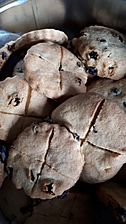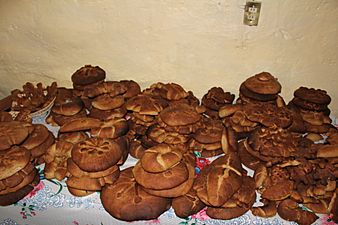Pan de ánimas facts for kids
The pan de ánimas (which means 'bread of souls'), pan de difunto ('bread of the deceased'), or pan de muerto ('bread of the dead') were special breads once made in Spain. People would prepare, bless, and offer these breads to their loved ones who had passed away during All Saints' Day (November 1) and All Souls' Day (November 2).
For a long time, bread in Europe and in the Christian religion was connected to both holy things and death. This connection goes way back, even to ancient Egypt, where people made bread from wheat as offerings for the dead. Pan de ánimas was also known as pan bendecido ('blessed bread') or pan de caridad ('charity bread').
A researcher named Luis de Hoyos Sainz wrote about these traditions in Spain in 1945. He noted that these customs were slowly disappearing, first in big cities and then in smaller towns. Today, some sweet breads eaten on All Saints' Day, like the fogassa from Valencia or the panellets from Catalonia, are based on these old pan de ánimas recipes.
Bread's Special Meaning
Bread became very important in Christian religious events, like during Lent or Holy Week. In Christianity, bread often represents new life, especially because of how dough rises. Long ago, people didn't know why bread dough got bigger, so they thought it was like a new life being created.
Bread also stood for togetherness among Christians. Newly married couples would receive bread on their wedding day, and it was used in many other ceremonies too. Bread offerings were also linked to death. It was common to offer bread at funerals. When someone died, people believed there should be "bread in the house to help them pass away."
Many European travelers who visited Spain between the 1400s and 1700s noticed how much Spanish people cared about remembering the dead. This special meaning of bread is clearly seen during the festa di San Giuseppe (St. Joseph's festival) in Sicily, which was once part of Spain. On March 19, loaves of bread are placed on altars.
In Siena, Italy, the All Saints' bread is called pan co' santi. It's a sweet bread with raisins, walnuts, anise, and a special wine called vin santo. It's also known as pan dei morti ('bread of the dead').
This European tradition traveled to America. Different kinds of pan de ánimas developed there. For example, the pan de muerto is placed on Mexican altars during the Day of the Dead. In the Andes mountains, tantawawas are also made for November 2.
- Bread, a divine offering
-
Bread bagels offered to San León in Benamaurel
-
Tavolata di San Giuseppe ('St. Joseph altar') with bread offerings in the province of Enna, Sicily
Today, bread is not seen as sacred or as important as it once was. Because of this, many cultural practices linked to it, like pan de ánimas, are slowly disappearing. A baker and author named Ibán Yarza, who traveled all over Spain to study local baking, says that "bread has lost its special meaning. It was once sacred because it was what people ate most. That's not true anymore." He adds that the religious phrase "our daily bread" doesn't make as much sense now because people eat less bread every day.
Spanish Traditions
Texts from the 1500s show that in Spain, it was common to visit cemeteries once a year. People would place bread, wine, and flowers on graves. Bread was a common offering on All Saints' Day and at funerals, especially in northern Spain.
In many churches in Galicia, Cantabria, Castile, Aragon, and Catalonia, people would bring breads, cocas (cakes), and tortas (flatbreads) on All Saints' Day. They would give them to the priest, who would bless them and then share them with everyone. Different rituals were done with these breads depending on the place.
These blessed loaves were offerings. Before eating them, people would say an Our Father for the souls of the dead. These bread offerings were called robos, which reminds us of ancient Roman religion. Historian Dolors Sanahuja says that "this custom was very old, and people believed the blessed bread had special powers."
Once blessed, the pan de ánimas was given to the poor as charity. Because this bread was considered sacred, it was often used for helping others. The Church even allowed people to go door-to-door asking for food for the dead. This is why today, some people still go door-to-door on All Saints' Day.
In the Canary Islands, a local version is called Finados, Finaos, or Pan por Dios. Children knock on neighbors' doors asking for "pan por Dios" (bread for God) or "Are there any little saints?" They would receive fig bread, fruit, nuts, and other foods. This tradition is similar to the Portuguese Pão-por-Deus.
In Castile, these breads were made in places like Segovia, where it was called pan de ánima. In Salamanca or León, it was called pan de muerto or pan de difunto. In Zamora, the women who collected pan de ánimas during the Mass for Souls were called "animeras." In Toledo, the All Saints' bread sometimes looked like a wrapped dead body.
In Portugal, similar bread offerings were also common. Until recently, it was typical to give bread to Portuguese widows on All Saints' Day. In Sicily, breads for the dead are shaped like people with their arms crossed. In other parts of Europe, the dough was shaped like human bones and covered with sugar.
In Galicia, the pan de difuntos was made with chestnut flour. Chestnuts were a very common ingredient in Galicia, especially during the Magosto (the Galician name for All Saints' Day), also known as castañada. These castañadas (chestnut festivals) as "funeral food" are common in the Leonese region, Asturias, Cantabria, Galicia, and even in Valladolid, Ávila, and Extremadura. In the Cantabrian Mountains, people used to place bread and other foods on graves on All Saints' night. Today, flowers have mostly replaced these food offerings.
In Catalonia, the castanyada is also a popular autumn festival. There is proof of pa d'ànimes (Catalan for 'bread of souls') throughout Catalonia, though the traditions changed from town to town. In many places, bread was offered in bowls to the dead on Sundays, at funerals, or on special days like November 1. In the past, some public ovens even had a special cabinet called an animer, where all the bread was placed. Women would later give this bread to remember the souls of the deceased. The Catalan bread for the dead was also called pa d'absoltes (absoltes are prayers for the deceased). Another Catalan bread for the dead is called pa de memòria. It's a loaf with a cross in the middle that was given to people attending a funeral after they ate together. Relatives would take the bread home, and when they ate it, they would remember the deceased and say prayers for them.

In the Balearic Islands, panets de mort were made for Tots Sants (All Saints' Day). These were tiny breads shaped like people (dead persons) or animals (rabbits). They have been around since the 1600s. These small buns were strung together like a rosary and given to children to teach them the custom of praying and remembering their deceased loved ones on November 1. Originally, they were made from bread dough, but later they were made with "Royal dough" (which is marzipan). In Minorca, the panets de mort are mentioned in a recipe book from 1923, which is one of the most complete books about the island's food. The custom of these breads also appears in a magazine article from 1927. It says that panets de mort were typical for All Saints' and All Souls' Day. Even though they were thought to be disappearing then, it suggests they might still have been made in private homes. Some recipes flavored these breads with anise. A culinary researcher from Minorca, Rosa Rotger, has helped bring this recipe back.
In Valencia, the fogassa de Tots Sants is a sweet flatbread made in towns across the Valencian Community. It's similar to a brioche bread, but its dough includes sweet potato, nuts, and sometimes anise.
In America
All Saints' bread preparations can be found in Mexico, Peru, Bolivia, and Ecuador. They have also been recorded in Guatemala, Colombia, and northern Argentina.
See also
 In Spanish: Pan de ánimas para niños
In Spanish: Pan de ánimas para niños







